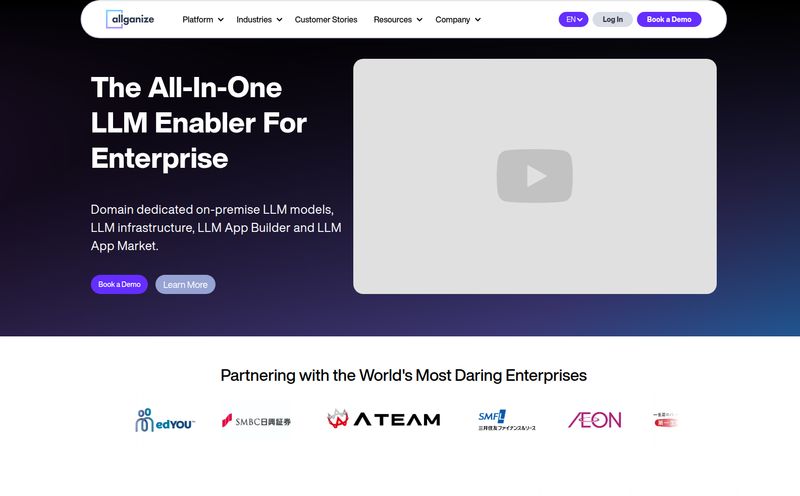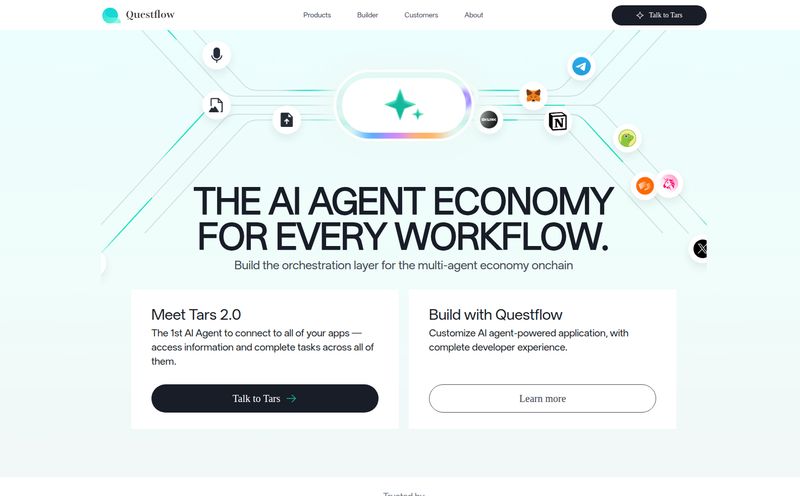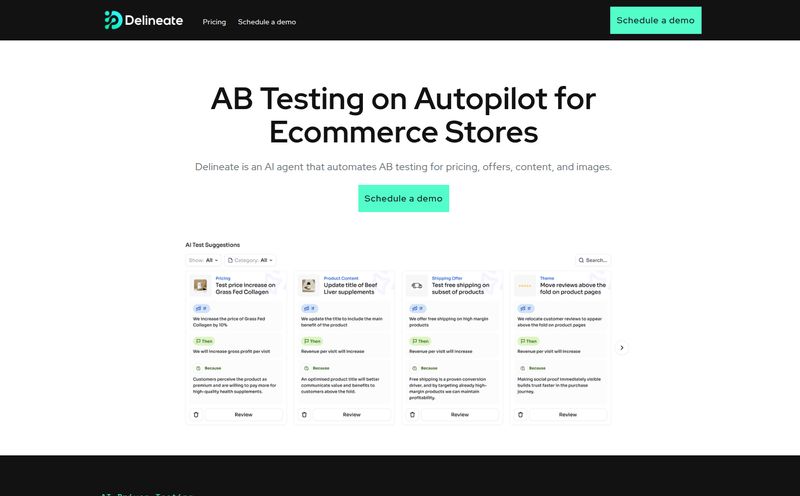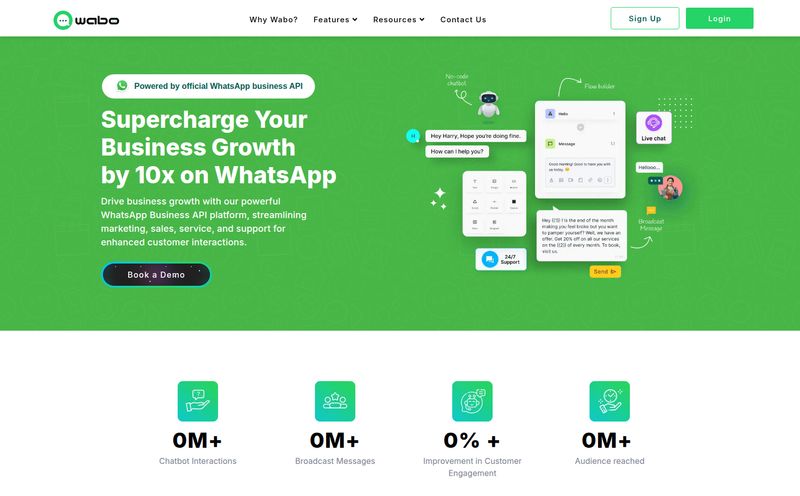You and me. As someone who's spent years staring at Google Analytics, obsessing over bounce rates, and trying to squeeze every last drop of ROI from a CPC campaign, I can tell you one thing for certain: online forms are a quiet killer of conversions.
We spend all this time and money getting traffic to our sites, crafting the perfect landing page copy, and then we hit them with it. A boring, sterile, multi-field form that feels more like filling out tax paperwork than starting a relationship with a brand. And what happens? They bail. Especially on mobile. The drop-off is just… painful to watch.
For the longest time, we just accepted this as the cost of doing business online. But what if the forms themselves are the problem? What if they're fundamentally broken? I stumbled across a tool called BuildForm recently, and their entire homepage leads with this bold claim. Naturally, my curiosity was piqued.
So, What Exactly is BuildForm?
Okay, at its core, BuildForm is an online form builder. But that’s like saying a smartphone is just a device for making calls. It completely misses the point. BuildForm is an AI-powered conversational form builder. Instead of presenting a static list of questions, it aims to create a dynamic, chat-like experience for the user.
Think of it like this: a traditional form is like a grumpy DMV employee sliding a clipboard through a window. A BuildForm is like a friendly concierge asking how they can help you today. It’s designed to feel less like a chore and more like a conversation, which, in theory, should make people more likely to stick around and actually finish the thing.
The Features That Actually Matter
I've seen a million platforms with a laundry list of features. Most of them are just noise. With BuildForm, a few things really stood out to me as genuinely useful for anyone trying to generate leads or gather information online.
The AI Magic: More Than Just a Buzzword
AI is slapped onto everything these days, right? But here, it feels like it has a real purpose. The AI Form Creation is a pretty neat starting point. You can give it a prompt like “Create a lead generation form for a digital marketing agency,” and it will spit out a logical, conversational flow of questions. It’s not always perfect, but it’s a heck of a lot faster than starting from scratch.
Where it gets more interesting is with things like AI Lead Nurturing. The form can adapt based on user answers, keeping them engaged. This isn’t just about showing the next question; it's about making the interaction feel smarter and more personalized. It's a subtle shift, but an important one.
Finally, Analytics That Don't Put You to Sleep
This is the part that got the data-nerd in me excited. BuildForm tracks partial submissions. Let me say that again. Partial. Submissions. This is a goldmine. It means you can see the data from users who started filling out your form but didn’t hit ‘submit.’
Why is this so huge? Because it tells you exactly where you're losing people. Is everyone dropping off at the “Phone Number” field? Maybe you should make it optional or remove it entirely. This isn't guesswork; it's actionable data. You also get insights into drop-off rates and completion times, which helps you fine-tune your forms into lean, mean, conversion machines.
Playing Nice with Your Other Tools (Integrations)
No tool is an island. If it doesn’t integrate with my existing workflow, I’m not interested. BuildForm gets this. It has the standard, essential integrations like Google Sheets and Zapier. The Zapier connection is the key, obviously, because it opens the door to thousands of other apps. You can pipe your new leads directly into your CRM, email marketing platform, or Slack channel without any manual work. It's a non-negotiable feature for any serious marketing tool, and they have it covered.
The Elephant in the Room: How BuildForm Stacks Up
It's impossible to talk about a new form builder without mentioning the old guard: Typeform, Jotform, and the ever-present Google Forms. I've used them all extensively. Google Forms is free and functional but… basic. It’s the beige Toyota Camry of forms.
Typeform really pioneered the one-question-at-a-time, conversational feel, and I give them major credit for that. But BuildForm seems to be taking that concept and layering a powerful AI and analytics engine on top of it. Looking at their on-site comparison, they directly call out their advantages in things like native AI creation and partial submission tracking, which are genuine differentiators.
It feels like a classic case of the new generation learning from the previous one. The older platforms walked so BuildForm could run—with an AI-powered jetpack.

Visit BuildForm
Let's Talk Money: BuildForm Pricing
Alright, the all-important question: what's this going to cost me? BuildForm’s pricing is pretty straightforward and, honestly, quite competitive. They run on a freemium model.
- Free Forever ($0): This is a genuinely useful free plan. You get unlimited forms, unlimited submissions, and basic analytics. It's perfect for individuals or small projects just getting started. The main catch? You'll have BuildForm branding on your forms, and you miss out on the advanced stuff.
- Starter ($23/month, billed yearly): This feels like the sweet spot for most freelancers and small businesses. It removes the branding, unlocks integrations like Zapier, and gives you more robust features. If you're generating leads, the cost is easily justified by capturing just one or two extra clients.
- Business ($99/month, billed yearly): For larger teams and companies that are serious about optimization. This tier brings in advanced analytics, priority support, and more controls. If you have significant traffic and a dedicated marketing team, this is where the powerful insights live.
- Enterprise (Custom): The classic “call us for a quote” plan for big-league players who need things like HIPAA compliance, SSO, and dedicated support.
My take? The value here is solid. When you consider that their own data suggests a 2x higher completion rate, the tool could easily pay for itself by preventing lost leads.
The Not-So-Perfect Bits
No tool is perfect, and it’s important to be real about that. Based on their plans, the first thing that jumps out is that custom branding is a paid feature. This is pretty standard practice in the SaaS world, but it's always a slight bummer when you're trying to get by on a free plan. You have to be okay with their logo on your form.
Also, the AI form creation has limits on the lower-tier plans. They give you a taste on the free plan, which is smart on their part, but to really lean into the AI capabilities, you'll need to be on a paid tier. It’s less of a con and more of a reality of the business model, but something to be aware of.
My Final Verdict: Should You Switch to BuildForm?
So, here’s my bottom line. If you’re a marketer, a small business owner, an agency, or frankly anyone who relies on a website to generate leads, I think you owe it to yourself to give BuildForm a serious look. The traditional “name, email, message” form is a leaky bucket, and we're pouring our precious ad spend into it.
BuildForm isn’t just another way to build a form; it's a different philosophy. It’s about engagement, data, and optimization. The ability to track partial submissions alone is a game-changer for understanding user behavior.
Is it for everyone? Maybe not. If you just need a one-time, super-simple RSVP form for a company potluck, Google Forms is probably fine. But if you’re trying to grow a business and you suspect your forms are costing you money, then yes. This is a tool built to solve that exact problem.
In Closing
The online world is noisy. Getting someone's attention is hard enough; keeping it long enough for them to give you their information is even harder. Tools like BuildForm are a clear sign that the future of online interaction is smarter, more personal, and more conversational. Stop letting your forms be a boring roadblock. It might be time to turn them into your best new conversion asset.
Frequently Asked Questions
- What is BuildForm in simple terms?
- BuildForm is an online tool that helps you create forms that feel more like a conversation than a questionnaire. It uses AI to make the forms more engaging, which helps increase completion rates and generate more leads.
- Is BuildForm really free to use?
- Yes, it has a "Free Forever" plan that offers unlimited forms and submissions with basic features. For more advanced capabilities like removing their branding, using integrations, and getting deeper analytics, you would need to upgrade to a paid plan.
- What makes BuildForm better than Google Forms?
- While Google Forms is great for simple surveys, BuildForm is a specialized marketing tool. Its main advantages are its conversational AI features, the ability to track partial submissions (seeing data from incomplete forms), and advanced analytics designed to help you improve conversion rates.
- Can I integrate BuildForm with my CRM or email software?
- Yes, absolutely. BuildForm integrates with Zapier, which acts as a bridge to connect with thousands of other applications, including popular CRMs like HubSpot and Salesforce, and email marketing platforms like Mailchimp.
- What are partial submissions and why do they matter?
- A partial submission is when a user starts filling out your form but leaves before hitting the submit button. BuildForm captures this data, allowing you to see how far they got. This is incredibly valuable because it shows you exactly where in the form process users are getting stuck or losing interest.
- Is BuildForm a good tool for lead generation?
- Yes, that is one of its primary strengths. By making forms more conversational and less intimidating, it's designed to reduce drop-off rates. Features like AI-driven questions and partial submission tracking are built specifically to help businesses capture and understand more leads.



